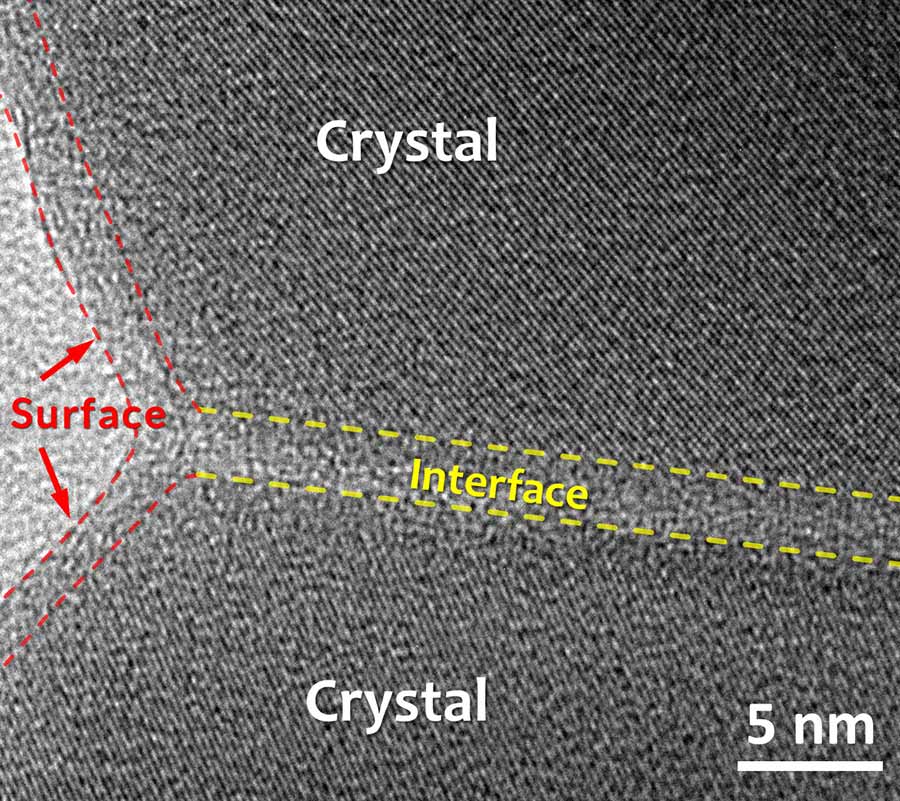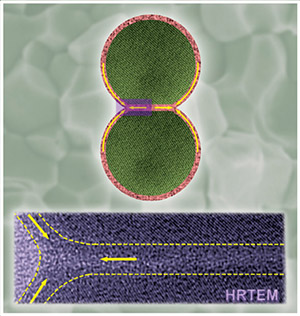Designing Better Materials for the 21st Century
Published Date
By:
- Catherine Hockmuth
Share This:
Article Content

An atomic-resolution electron micrograph showing that nanometer-thick, liquid-like, interfacial phases can develop before the bulk crystals melt. Image courtesy of Jian Luo, Department of NanoEngineering, UC San Diego Jacobs School of Engineering.
The U.S. Defense Department recently named Jian Luo, professor of nanoengineering and materials science and engineering at the University of California, San Diego as one of 10 new National Security Science and Engineering Faculty Fellows (NSSEFF). The award provides up to $3 million over five years to develop a new materials design tool called interfacial phase diagrams.
The NSSEFF program is the largest single principal investigator basic research grant funded within the Department of Defense to support top-tier researchers from U.S. universities to conduct long-term, unclassified, basic research.
Interfacial phase diagrams enable scientists to tailor the processing and properties of engineering materials. Luo believes this basic research can also help to design better materials for applications in energy generation and storage.
Luo’s project focuses on developing structural materials, including molybdenum-based high-temperature alloys and zirconia-based structural ceramics for aerospace and naval applications.

Nanoengineering professor Jian Luo was recently named a National Security Science and Engineering Faculty Fellow by the Defense Department. Luo's project focuses on developing interfacial phase diagrams to build better structural materials, including molybdenum-based high-temperature alloys and zirconia-based structural ceramics for aerospace and naval applications. Image printed with permission by Wiley. Journal of the American Ceramic Society. © 2012 The American Ceramic Society
A piece of ice melts at 0 degrees Celsius, but a nanometer-thick layer on the surface of ice can melt at tens of degrees below zero. This phenomenon of stabilization of nanoscale liquid-like interfacial “phases” below the normal bulk melting temperatures, known as “premelting,” was first recognized by the physicist Michael Faraday in 1842.
Since then, materials scientists have discovered that the surfaces and interfaces in engineered materials can exhibit more complex phase-like behaviors at high temperatures, which can affect the fabrication and properties of a broad range of metallic alloys and ceramic materials. Phase diagrams provide the basic information on the phase stability and the conditions for phase transitions. For example, the ice-water phase transition occurs at 0 degrees Celsius in the ambient atmosphere. Since interfaces can undergo transitions such as premelting at conditions different from bulk materials and drastically change materials properties, new interfacial “phase” diagrams (also called “complexion diagrams”) need to be developed.
Nanoengineering research collaboration
This NSSEFF project at UC San Diego Jacobs School of Engineering will be significantly strengthened by the participation of two junior nanoengineering faculty members, Shyue Ping Ong and Kesong Yang as senior personnel who will bring valuable expertise of first-principles quantum-mechanical calculations and high-throughput computational materials design. Theoretical advances have made it possible to use computers to predict many properties of materials before they are ever synthesized in the laboratory. Exponential growth in computing power has also meant that researchers can now predict these properties for more materials than ever before.
Both Ong and Yang joined the UC San Diego Jacobs School of Engineering in 2013. Ong recently received a prestigious Department of Energy Early Career Award to support his work using supercomputing to discover new materials that could be used to build more energy-efficient technologies.
National Security Science and Engineering Faculty Fellowship
The NSSEFF program also has a goal to develop the next generation of scientific workforces. In addition to two assistant professors, three postdoctoral fellows, three Ph.D. students and multiple undergraduate researchers are expected to participate in this research and receive valuable training in the areas of physical metallurgy, ceramics and computational materials design.
Share This:
You May Also Like
UC San Diego is Strengthening U.S. Semiconductor Innovation and Workforce Development
Technology & EngineeringStay in the Know
Keep up with all the latest from UC San Diego. Subscribe to the newsletter today.



